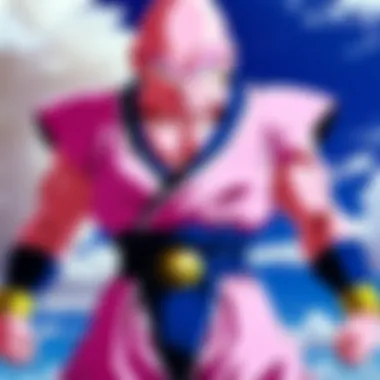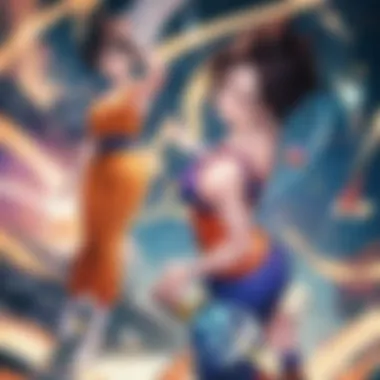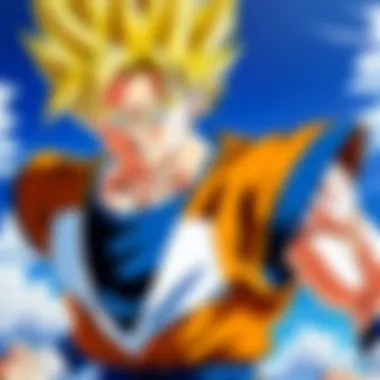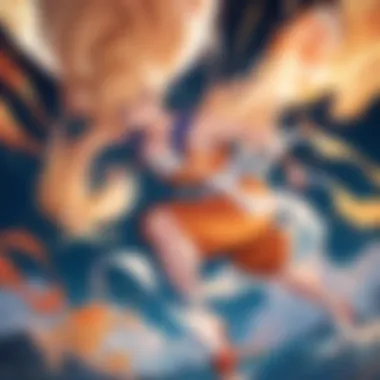The Buu Saga in Dragon Ball Z Kai: An In-Depth Analysis


Intro
The Buu Saga marks a critical point in the Dragon Ball Z Kai narrative. It introduces viewers to new characters, vivid conflicts, and profound themes that resonate well beyond the screen. This section sets the stage for discussing these elements in detail. We will explore how the saga not only expands the lore of the Dragon Ball universe but also influences modern anime and manga culture.
As we delve into this analysis, we hope to provide readers with insights that enhance their understanding of the Buu Saga's significance, character development, and intrinsic themes.
Series Overview
Synopsis and Premise
The Buu Saga encapsulates the adventures of Goku, Vegeta, and their allies as they confront the formidable Majin Buu. This saga begins with the emergence of a new villain, Bibidi, who resurrects Majin Buu with the intent of wreaking havoc across the universe. This arc explores the delicate balance between good and evil, showcasing how characters evolve in the face of dire circumstances.
Throughout the saga, viewers witness epic battles and transformative moments as heroes grapple with their past, their responsibilities, and the meaning of power. By pitting characters against their inner demons and external foes, the Buu Saga captivates audiences and maintains a compelling narrative drive.
Notable Characters
Several characters shine in this saga, each contributing uniquely to the storyline:
- Goku: The ever-optimistic fighter who embodies determination and a quest for self-improvement.
- Vegeta: Goku's rival who battles internal conflicts about pride and his role as a protector.
- Majin Buu: The antagonist whose complex nature—displaying both childlike innocence and devastating power—adds depth to the conflict.
- Gohan: As a pivotal character, Gohan's transformation reflects growth and sacrifice.
Each character's journey intertwines, leading to explosive confrontations and moral dilemmas, making the Buu Saga rich with character dynamics.
Themes and Motifs
Major Themes Explored
The Buu Saga doesn't shy away from exploring dense themes that resonate on multiple levels:
- Friendship and Loyalty: Represented through the unity among fighters in tough battles.
- Sacrifice: Many characters face choices that require them to put their lives on the line for others.
- Redemption: Majin Buu's character arc illustrates the potential for change, even in beings with a dark past.
These themes contribute to a narrative that invites viewers to reflect on their own experiences and moral beliefs.
Symbolism in Storytelling
Within the Buu Saga, symbolism plays an essential role. The transformation of characters often represents their struggles and identity crises. For example, Majin Buu's different forms symbolize his shifting personas, each reflecting varying aspects of his character from chaotic evil to tender vulnerability.
"The Buu Saga teaches us about the duality of character and how transformation can lead to both chaos and harmony."
Artistic Style and Animation
Visual Aesthetics and Design


The artistic style of Dragon Ball Z Kai adapts beautifully through the Buu Saga. The character designs maintain a vibrant and energetic appearance while staying true to the original series. The colored palettes during battles enhance the emotions presented, often mirroring a character's state of mind.
Animation Techniques and Trends
In terms of animation, the Buu Saga utilizes dynamic fight sequences that keep the audience engaged. With the mix of traditional hand-drawn frames and digital enhancements, the action moves fluidly, creating an experience that is stimulating and visually appealing.
The pacing and choreography of fights also reflect modern trends in anime, where attention to detail creates a more immersive viewing experience.
Through this analysis, we look forward to uncovering further intricacies of the Buu Saga. Each character, theme, and artistic choice contributes to the overall narrative, making it a noteworthy discussion within the Dragon Ball Z Kai universe.
Foreword to the Buu Saga
The Buu Saga is often considered a turning point in the Dragon Ball Z Kai series. This section sets the stage for understanding the significance of this particular arc. The Buu Saga not only introduces new characters and complex storylines but also encapsulates deeper themes related to identity, transformation, and morality. Its contrast with previous sagas is stark, highlighting character growth, conflict, and resolution.
Overview of Dragon Ball Z Kai
Dragon Ball Z Kai serves as a remastered version of the original Dragon Ball Z. This series aims to condense the episodes for a more streamlined viewing experience. By eliminating filler arcs and enhancing the animation quality, it presents the core narrative more engagingly. The Buu Saga represents a crucial segment of this refined storytelling, as it showcases the maturation of the characters, particularly Goku and Vegeta, as they face unprecedented challenges. The transition from battling Saiyan foes to the mystical threat of Majin Buu marks a significant shift in tone, compelling viewers to reassess the nature of heroism and villainy.
Placement of the Buu Saga within the Series Timeline
In the timeline of Dragon Ball Z Kai, the Buu Saga follows the Cell Saga, concluding the broader narrative of the series. This positioning is critical as it reflects the evolution of the characters through intense trials and tribulations. The events leading up to the Buu Saga build anticipation and context for the conflict that arises with Majin Buu. Characters evolve markedly, with many confronting their earlier choices and consequences.
The Buu Saga directly connects to previous arcs by exploring themes of redemption and sacrifice, serving as a conclusion to several character arcs while setting the stage for new developments. The introduction of characters like Uub, who represents Goku's legacy, emphasizes the cyclical nature of the story. With multi-layered plots and character dynamics, the Buu Saga encapsulates a transformative phase for Dragon Ball Z Kai, inviting audiences to reflect on the intricate tapestry of its narrative.
Narrative Structure of the Buu Saga
The narrative structure of the Buu Saga stands as a vital component in understanding its impact within the broader Dragon Ball Z Kai series. This saga uniquely weaves together multiple plots, presenting a rich tapestry of character interactions and thematic elements. Each layer in its narrative contributes to the overall emotional depth and stakes of the story, enhancing the audience’s engagement.
Plot Development and Key Arcs
The Buu Saga can be divided into several key arcs, each signifying distinct plot developments while maintaining a cohesive storyline. The initial arc introduces Majin Buu, initially portrayed as an innocent creature but gradually evolving into a substantial threat. The duality in Buu's character reflects a complicated narrative strategy that enriches the plot.
- Buu’s Awakening: This marks the start of real chaos. The conflict escalates with the emergence of powerful beings like Kid Buu, showcasing the unpredictable nature of some adversities faced by the heroes.
- Goku and Vegeta's Rivalry: Their relationship highlights motivations adding layers to the overall conflict. Each character’s growth through rivalry becomes a focal point of the narrative.
- The Fusion Technique: The introduction of techniques like Fusion plays a pivotal role, altering combat dynamics. This reflects both character development and new storytelling possibilities, allowing for creative resolutions in battles.
These arcs combine to show a rich interplay of triumphs and failures, emphasizing individual and collective struggles. The complexity in character choices shapes the direction of the fights, further pushing the narrative forward.
Pacing and Storytelling Techniques
Pacing in the Buu Saga varies significantly, which reflects the intensity of its overarching themes. Each episode often balances moments of high-octane battles with essential character moments, which grounds the audience amidst the chaos.
Several storytelling techniques underline the pacing:


- Fractured Timeline: The non-linear progression of events adds to both suspense and intrigue. Flashbacks and time skips complement the ongoing fights, revealing motivations and establishing context rather than creating confusion.
- Thematic Clustering: By grouping character actions around central themes such as friendship and sacrifice, the narrative remains focused. This allows deeper exploration of character arcs without neglecting fast-paced fight sequences.
- Strategic Cliffhangers: The use of cliffhangers at pivotal moments encourages viewers to stay engaged. This technique fosters anticipation for future installments while enriching character motivations.
The combination of pacing techniques creates a rhythm that not only keeps viewers interested but also advances overall themes significantly. The careful orchestration of scenes is fundamental to understanding the saga’s essence, as it meticulously constructs tension and release, mirroring character evolution and relationships.
Major Characters of the Buu Saga
The characters in the Buu Saga play an essential role, driving the narrative forward and adding layers of complexity to the plot. Each character brings unique challenges, emotions, and growth opportunities that contribute to the overall theme of the saga. Understanding the major characters is key to grasping the intricacies of the storyline and its impact on the Dragon Ball Z universe.
Goku's Role and Evolution
Goku stands as the primary figure throughout the Buu Saga. His journey of evolution is integral not only to his character development but also to the series itself. Initially, Goku is portrayed as a powerful defender of Earth, yet he continues to seek even greater challenges. He evolves by mastering new forms like Super Saiyan 3, showcasing his relentless pursuit of strength. This evolution highlights his unwavering spirit and commitment to protect his loved ones.
Goku's character also faces moral dilemmas during the Saga. He often prioritizes battles over the potential consequences, which leads to critical events, especially with his approach towards Majin Buu. This reflects a nuanced aspect of his character: the balance between being a hero and the responsibilities that come with power.
Vegeta: Redemption and Complexity
Vegeta’s arc in the Buu Saga is marked by profound complexity and redemption. Initially introduced as a villain, his character gradually transforms through guilt and loss. He struggles with his past and pride as a Saiyan. In this saga, we witness Vegeta confront his weaknesses, particularly during his moments of sacrifice. The iconic scene where he embraces his role as a father provides a stark contrast to his prior ruthlessness.
Vegeta's fight against Majin Buu notably shifts his character. Here, he acknowledges his need to protect not only his family but Earth as well. This evolution enriches the narrative, showing that redemption is possible even for the most flawed individuals. Fans are drawn to Vegeta’s internal conflicts, making him one of the most compelling characters in the series.
Majin Buu: The Antagonist's Depth
Majin Buu represents a unique antagonist in the Dragon Ball Z Kai universe. Unlike typical villains, Buu embodies a range of personalities, from the child-like and whimsical to the menacing and destructive. This duality makes Buu an intriguing character with layers of complexity.
His origin story contributes to understanding his actions. Created from the dark impulses of ancient sorcery, Buu is more than a simple villain; he reflects themes of chaos and innocence. The transformation between forms—from Fat Buu to Kid Buu—showcases his unpredictable nature. This segmentation of personality adds depth and intrigue to the narrative, challenging the heroes in both physical confrontations and moral dilemmas.
Moreover, Buu's interactions with other characters, particularly with Mr. Satan and the other Z Fighters, reveal moments of unexpected empathy and growth, which complicate the notion of good versus evil.
Other Key Players in the Saga
The Buu Saga introduces several other critical characters who contribute significantly to the narrative. Each of these characters adds their unique perspectives and experiences to the story, enhancing its richness.
- Gohan: Gohan’s character transitions from a powerful warrior to a more complex figure who grapples with expectations and pressures as a fighter. His efforts to secure peace showcase a more mature yet conflicted hero.
- Mr. Satan: Initially seen as comic relief, Mr. Satan’s character grows in importance. His relationship with Buu evolves, providing moments of humor and warmth that contrast the violence of battles.
- Piccolo: As a mentor and guardian figure, Piccolo's wisdom and experience play a crucial role in shaping the strategies against Buu. His character adds depth to the representation of teamwork.
Themes and Motifs
The exploration of themes and motifs in the Buu Saga is essential to understanding both its narrative and its impact on the audience. Within this arc, several significant themes emerge, each contributing to character development, plot progression, and the emotional resonance of the storyline. These themes help create a rich tapestry that enhances viewer engagement and provides a deeper philosophical reflection on the nature of the characters and their struggles.
Good vs. Evil Dichotomy
The struggle between good and evil is a cornerstone of many narratives, and the Buu Saga presents this conflict in a complex manner. While the series initially portrays Majin Buu as a purely evil entity, the layers of his character reveal more intricate truths. His transformations showcase shifts in personality, ranging from mindless destruction to moments of innocence and vulnerability. This complexity invites viewers to reconsider their definitions of good and evil, bringing to light the idea that motives and context can define these moral concepts.


"In the realm of Dragon Ball, the line between hero and villain is fluid, often driven by the characters’ growth and their relationships with each other."
Importance of Friendship and Sacrifice
Friendship and sacrifice are pivotal themes that resonate throughout the Buu Saga. The connections between characters serve as a foundation for their strength and resolve. Goku’s unwavering support for his friends emphasizes the idea that true power comes from unity and trust. Moreover, sacrifices made by characters such as Goku and Vegeta illustrate the gravity of their commitment to protect their loved ones and the world around them. This emphasis on relationships as a source of power deepens the narrative and underscores the emotional stakes of the battles fought.
Transformation and Identity
Transformation is not just a physical change in Dragon Ball; it often reflects deeper questions of identity and purpose. In the Buu Saga, characters undergo significant transformations, both literal and metaphorical. Goku continues to evolve through newfound powers, while Vegeta confronts his past and seeks redemption. Majin Buu's various forms illustrate the struggle between his inherent nature and the possibility of change. This theme invites the audience to reflect on their own identities and the factors that shape who they are, making it more relatable and thought-provoking.
In summary, the themes and motifs of the Buu Saga not only enrich the narrative but also facilitate a deeper connection with the audience. By examining the complexities of good versus evil, the significance of friendship and sacrifice, and the exploration of transformation and identity, viewers gain insights into the moral and emotional framework of the series. Such themes make the Buu Saga a critical part of the Dragon Ball universe and its cultural legacy.
Cultural Impact of the Buu Saga
The Buu Saga represents a defining period in the Dragon Ball Z Kai narrative, marking not only a chapter within the series but also leaving a lasting impression on the anime and manga landscape. Understanding its cultural impact requires an examination of both the immediate audience reactions as well as its long-term influence on other shows and genres. This section elucidates how the Buu Saga resonated with fans and critics alike, and how it paved the way for narrative exploration in future mediums.
Reception by Fans and Critics
The Buu Saga received a mixed reception from both fans and critics, often sparking passionate discussions. Some fans viewed it as a departure from the intense battles seen in earlier arcs, while others appreciated the character development and thematic complexity it introduced.
- Character Development: The evolution of characters such as Goku and Vegeta served to further engage audiences. Fans appreciated the portrayal of Vegeta’s redemption arc, as well as Goku’s growth, which contrasted the series’ earlier narratives focused primarily on fighting.
- Plot and Pacing Issues: Critics highlighted pacing issues, noting that the storyline could feel drawn out at times. This was especially evident in segments that featured more comedic elements, which some audiences found less compelling compared to the darker tones earlier in the series.
- Cultural References: The integration of various cultural elements, from mythology to contemporary themes, contributed to the saga's appeal. Fans pointed out how these influences enriched the storyline and provided deeper insight into character motivations.
Despite the divided opinions, the overall impact of the Buu Saga on its viewers cannot be overstated. It served as a catalyst for discussions about the nature of good and evil, individual sacrifice, and the complexities of identity in both narrative and character portrayal.
Influence on Subsequent Anime and Manga
The ripple effects of the Buu Saga can be seen in various subsequent anime and manga series. By challenging the conventions of storytelling and character development, it inspired creators to embrace more complex arcs and darker themes in their narratives.
- Inspirational Character Arcs: Many series that followed borrowed concepts of redemption arcs similar to those seen with Vegeta. The idea of flawed characters seeking redemption became a common motif in later anime narratives.
- Thematic Depth: The themes explored in the Buu Saga, such as friendship, sacrifice, and identity, influenced many series in their pursuit of emotionally resonant storytelling. Shows such as Naruto and My Hero Academia demonstrate similar explorations of character relationships and personal growth that can be traced back to the Buu Saga.
- Diverse Genres: The Buu Saga straddled elements of action, comedy, and drama, encouraging subsequent anime to blend genres more fluidly. Series like One Piece and Attack on Titan showcase this blend, reflecting the narrative flexibility established in the earlier Dragon Ball Z arcs.
"The Buu Saga reshaped how narratives are constructed within the anime genre, leading to a richer and more diverse storytelling landscape."
Ending
The conclusion of the Buu Saga holds significant weight within the context of the entire Dragon Ball Z Kai series. This part of the article encapsulates the multiple dimensions of the saga, reinforcing its pivotal role in both character evolution and thematic development. It is essential to realize how the Buu Saga serves not only as a culmination of various plot threads but also as a lens through which we can examine the broader implications of the series.
Overall Significance of the Buu Saga
The Buu Saga is not merely another arc in the narrative but represents a turning point in the Dragon Ball Z franchise. It introduces complex layers of conflict and resolution among the characters. For example, Goku and Vegeta's relationship evolves dramatically, showcasing both rivalry and cooperation. This saga expands the universe and challenges established norms. The conflict with Majin Buu acts as a canvas for exploring themes such as despair, hope, and redemption.
Furthermore, the ending ties up various emotional storylines, offering closure for characters like Goku and his family. Fan responses to this arc indicate its profound impact, as many viewers found a deeper connection with the characters. The lasting legacy of the Buu Saga is evidenced by its continued discussion and analysis in various forums and communities dedicated to anime and manga.
Final Thoughts on Its Legacy
In considering the legacy of the Buu Saga, we must recognize its influence beyond mere entertainment. The saga contributes to the shaping of anime culture, inciting discussions on topic of morality, sacrifice, and the continuous struggle between good and evil. Its memorable moments and character arcs resonate with audiences, fostering emotional investments that remain vibrant decades after the original airing.
"The Buu Saga exemplifies how narrative complexity can enhance not just character depth, but also viewer engagement and investment."
In summary, the Buu Saga is indispensable when assessing the broader impact of Dragon Ball Z Kai. Its themes, character developments, and narrative intricacies provide a wealth of material for analysis, ensuring that its significance endures in both the Dragon Ball universe and the wider arena of anime.



